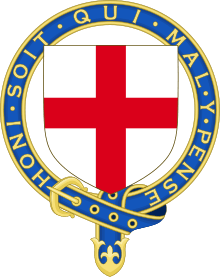Akihito
Akihito (明仁, Japanese: [akiꜜçi̥to], English: /ˌækiˈhiːtoʊ/ (![]()
| Akihito | |||||
|---|---|---|---|---|---|
 | |||||
| Emperor of Japan | |||||
| Reign | 7 January 1989 – 30 April 2019 | ||||
| Enthronement | 12 November 1990 | ||||
| Predecessor | Shōwa | ||||
| Successor | Naruhito | ||||
| Prime Ministers | See list
| ||||
| Born | Tsugunomiya (継宮) Akihito (明仁) 23 December 1933 Tokyo Imperial Palace, Tokyo City, Tokyo Prefecture, Japan (now Chiyoda ward, Tokyo, Japan) | ||||
| Spouse | |||||
| Issue | |||||
| |||||
| House | Yamato | ||||
| Father | Emperor Shōwa | ||||
| Mother | Empress Kōjun | ||||
| Religion | Shinto | ||||
| Signature |  | ||||
 |
|
|
HIH The Prince Hitachi HIH The Princess Hitachi |
Name
In Japan, during his reign, Akihito was never referred to by his given name, but rather was referred to as "His Majesty the Emperor" (天皇陛下, Tenno Heika) which may be shortened to "His Majesty" (陛下, Heika).[2] The era of Akihito's reign from 1989 to 2019 bears the name Heisei (平成), and according to custom he will be renamed Emperor Heisei (平成天皇, Heisei Tennō, see "posthumous name") as the 125th Emperor of Japan by order of the Cabinet after his death.
Upon Akihito's abdication on 30 April 2019, he received the title of Jōkō (上皇, Emperor Emeritus), an abbreviated form of Daijō Tennō (太上天皇, 'abdicated sovereign').[3][4][5] A new era, Reiwa (令和), was established when his son, Emperor Naruhito, acceded to the throne.
Life and work

Prince Akihito (明仁親王, Akihito Shinnō)) was born on 23 December 1933 at morning of 6:39 am in the Tokyo Imperial Palace, Tokyo, Japan as the fifth child and the eldest son of the Emperor Shōwa (father; Hirohito) and the Empress Kōjun (mother; Nagako), they had seven children, two sons and five daughters as their parents. Titled Prince Tsugu (継宮, Tsugu-no-miya) as a child, the emperor was educated by his private tutors prior to attending the elementary and secondary departments of the Peers' School (Gakushūin) from 1940 to 1952.[6] Unlike his predecessors in the Imperial family, he did not receive a commission as an army officer, at the request of his father, the Emperor Hirohito.
During the American firebombing raids on Tokyo in March 1945, Akihito and his younger brother, Prince Masahito (Yoshi-no-miya), were evacuated from the city. During the Allied occupation of Japan following the World War II, Prince Akihito was tutored in the English language and the Western manners by Elizabeth Gray Vining. He briefly studied at the Department of Political Science at Gakushuin University in Tokyo, though he never received a degree.
Akihito was heir-apparent to the Chrysanthemum Throne from the moment of his birth. His formal Investiture as Crown Prince (立太子の礼, Rittaishi-no-rei) was held at the Tokyo Imperial Palace on 10 November 1952. In June 1953 Akihito represented Japan at the Coronation of Queen Elizabeth II in London, the UK.[6]
Crown Prince Akihito and Crown Princess Michiko made official visits to thirty-seven countries. As an Imperial Prince, Akihito compared the role of Japanese royalty to that of a robot. He expressed the desire to help bring the Imperial family closer to the people of Japan.[7]
Upon the death of Emperor Hirohito on 7 January 1989, Akihito acceded to the throne,[8][9] became the 125th Emperor of Japan with the enthronement ceremony taking place on 12 November 1990.[6] In 1998, during a state visit to the United Kingdom, he was invested with the UK Order of the Garter.
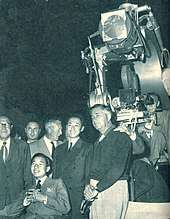
On 23 December 2001, during his annual birthday meeting with reporters, the Emperor, in response to a reporter's question about tensions with South Korea, remarked that he felt a kinship with Koreans and went on to explain that, in the Shoku Nihongi, the mother of Emperor Kammu (736–806) is related to Muryeong of Korea, King of Baekje, a fact that was considered taboo for discussion.[10][11]
Emperor Akihito underwent surgery for prostate cancer on 14 January 2003.[12]
In response to the 2011 Tōhoku earthquake and tsunami and the Fukushima I nuclear crisis, the Emperor made a historic televised appearance[13] urging his people not to give up hope and to help each other.[14] The Emperor and Empress also made a visit on Wednesday, 30 March 2011 to a temporary shelter housing refugees of the disaster, in order to inspire hope in the people. This kind of event is also extremely rare, though in line with the Emperor's attempts to bring the Imperial family closer to the people.[15] Later in 2011 he was admitted to hospital suffering from pneumonia.[16] In February 2012, it was announced that the Emperor would be having a coronary examination;[17] he underwent successful heart bypass surgery on 18 February 2012.[18]
Marriage and family
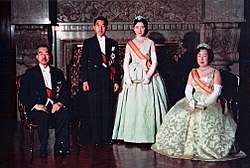
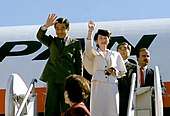
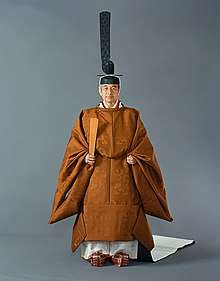
In August 1957, he met Michiko Shōda[6][19] on a tennis court at Karuizawa near Nagano. Initially there was low enthusiasm for the relationship between the couple. Michiko Shōda was considered too low-born for the young Crown Prince and was educated in a Catholic environment. Therefore, in September 1958, she was sent away to Brussels to attend an international conference of the Alumnae du Sacré-Cœur. The Crown Prince was determined to keep in contact with his girlfriend but also didn't want to commit a diplomatic incident. Therefore, he contacted the young King Baudouin of Belgium to send his messages directly towards his loved one. Later King Baudouin also negotiated the marriage of the couple with the Emperor directly stating that if the Crown Prince is happy with Michiko, he would be a better emperor later on.[20]
The Imperial Household Council formally approved the engagement of the Crown Prince to Michiko Shōda on 27 November 1958. At that time, the media presented their encounter as a real "fairy tale",[21] or the "romance of the tennis court". It was the first time a commoner had married into the Imperial Family, breaking more than 2,600 years of tradition.[22] The engagement ceremony took place on 14 January 1959, and the marriage on 10 April 1959.
The Emperor Emeritus Akihito and the Empress Emerita Michiko had three children: two sons Naruhito (born 23 February 1960; Prince Naruhito Hiro-no-miya, the 126th Emperor of Japan) and Fumihito, Prince Akishino (born 30 November 1965; Prince Fumihito Aya-no-miya), and a daughter Mrs. Sayako Kuroda (born 18 April 1969; Princess Sayako Nori-no-miya before marriage), The three children were born at Imperial Household Agency Hospital, Tokyo Imperial Palace in Tokyo.[6]
The announcement about the then-Crown Prince Akihito's engagement and marriage to the then-Ms. Michiko Shōda drew opposition from traditionalist groups, because Shōda came from a Roman Catholic family.[23] Although Shōda was never baptized, she was educated in Catholic schools and seemed to share the faith of her parents. Rumors also speculated that his mother, Empress Kōjun had opposed the engagement. After the death of Empress Kōjun on 16 June 2000, Reuters reported that she was one of the strongest opponents of her son's marriage, and that in the 1960s, she had driven her daughter-in-law and grandchildren to depression by persistently accusing her of not being suitable for her son.[24]
Official functions
According to the Constitution of Japan, the Emperor is "the symbol of the State and of the unity of the people". Unlike any other constitutional monarchs, his function is defined as entirely representative and ceremonial in nature, without even a nominal role in government. He is limited to acting in matters of state as delineated in the Constitution, and even in those matters, he is bound by the requirements of the Constitution and the binding advice of the Cabinet. For instance, while he formally appoints the Prime Minister, he is required to appoint the person designated by the Diet, without the option to decline appointment.
Despite being strictly constrained by his constitutional position, he also issued several wide-ranging statements of remorse to Asian countries, for their suffering under Japanese occupation, beginning with an expression of remorse to China made in April 1989, three months after the death of his father, the Emperor Showa (Hirohito).
In June 2005, the Emperor Akihito and the Empress Michiko visited the island of Saipan (part of the Northern Mariana Islands, a U.S. territory),[25] the site of a battle in the World War II from 15 June to 9 July 1944 (known as the Battle of Saipan). Accompanied by Empress Michiko, he offered prayers and flowers at several memorials, honoring not only the Japanese who died, but also American soldiers, Korean labourers, and local islanders. It was the first trip by a Japanese monarch to a World War II battlefield abroad. The Saipan journey was received with high praise by the Japanese people, as were the Emperor's visits to war memorials in Tokyo, Hiroshima Prefecture, Nagasaki Prefecture and Okinawa Prefecture in 1995.
Since succeeding to the throne, Akihito has made an effort to bring the Imperial family closer to the Japanese people. He and Michiko have made official visits to eighteen countries and to all forty-seven Prefectures of Japan.[6]
Succession
On 6 September 2006, the Emperor celebrated the birth of his first grandson, Prince Hisahito, the third child of the Emperor's younger son. Prince Hisahito is the first male heir born to the Japanese imperial family in 41 years (since his father Prince Akishino) and could avert a possible succession crisis as the Emperor's elder son, the then Crown Prince Naruhito, has only one daughter, Princess Aiko. Under Japan's male-only succession law, Princess Aiko is not eligible for the throne. The birth of Prince Hisahito could mean that proposed changes to the law to allow Aiko to ascend the Chrysanthemum Throne will not go through after being temporarily shelved following the announcement of Princess Kiko's third pregnancy in February 2006.[26] The supporters of changes criticized the current law as it placed a burden on the few aging males old enough to perform royal duties as females left the family.[27]
Abdication
On 13 July 2016, national broadcaster NHK reported that the Emperor intended to abdicate in favor of his eldest son Crown Prince Naruhito within a few years, citing his age. An abdication within the Imperial Family has not occurred since Emperor Kōkaku in 1817. However, senior officials within the Imperial Household Agency denied that there was any official plan for the monarch to abdicate. Abdication by the Emperor required an amendment to the Imperial Household Law, which had no provisions for such a move.[28][29] On 8 August 2016, the Emperor gave a rare televised address, where he emphasized his advanced age and declining health;[30] this address was interpreted as an implication of his intention to abdicate.[31]
On 19 May 2017, the bill that would allow Akihito to abdicate was issued by the Japanese government's cabinet. On 8 June 2017, the National Diet passed a one-off bill allowing Akihito to abdicate, and for the government to begin arranging the process of handing over the position to Crown Prince Naruhito.[32] The Japanese government (Prime Minister Shinzo Abe) announced in December 2017 that the 125th Emperor Akihito would abdicate on 30 April 2019, and that the 126th Emperor Naruhito's reign would begin as of 1 May 2019.[1]
On 19 March 2020, the Emperor Emeritus Akihito and his wife the Empress Emerita Michiko moved out of the Imperial Palace, marking their first public appearance since the abdication.[33]
Ichthyological research
In extension of his father's interest in marine biology, who published taxonomic works on the Hydrozoa, the Emperor Emeritus is a published ichthyological researcher, and has specialized in studies within the taxonomy of the family Gobiidae.[34] He has written papers for scholarly journals such as Gene, Ichthyological Research, and the Japanese Journal of Ichthyology.[35] [36] He has also written papers about the history of science during the Edo and Meiji eras, which were published in Science[37] and Nature.[38] In 2005, a newly described goby was named Exyrias akihito in his honour, and in 2007 a genus Akihito of gobies native to Vanuatu also received his name.



.svg.png)



Titles, styles, honours and arms
| Styles of Akihito | |
|---|---|
 | |
| Reference style | His Majesty |
| Spoken style | Your Majesty |
| Alternative style | Sir |
Titles and styles
- 23 December 1933 – 10 November 1952:
- His Imperial Highness The Prince Tsugu, Akihito (継宮明仁親王殿下 Tsugu-no-miya Akihito Shinnō Denka)
- 10 November 1952 – 7 January 1989:
- His Imperial Highness The Crown Prince (皇太子殿下 Kōtaishi Denka)
- His Imperial Highness The Crown Prince Akihito (皇太子明仁親王殿下 Kōtaishi Akihito Shinnō Denka)
- 7 January 1989 – 30 April 2019:
- His Majesty The Emperor (天皇陛下 Tennō Heika)
- 1 May 2019 – present:
- His Majesty The Emperor Emeritus (上皇陛下 Jōkō Heika)[39]
Honours
National honours


_1Class_BAR.svg.png)

.svg.png)
.svg.png)
Foreign honours
| Country | Awards |
|---|---|
- FR Yugoslavia split into Serbia and Montenegro. As of 2006 this order is аbolished.
- Zaire is now the Democratic Republic of the Congo.
- Other awards
Foreign Arms
.svg.png) Akihito as Knight of the Garter
Akihito as Knight of the Garter.svg.png) Akihito as Knight of the Golden Fleece
Akihito as Knight of the Golden Fleece.svg.png) Akihito as Knight of the Royal Order of the Seraphim
Akihito as Knight of the Royal Order of the Seraphim
Overseas visits
The following table includes the official visits made by Emperor Akihito, along with Empress Michiko, following succession to the throne on 7 January 1989.[52][53][54] The list includes all the visits made up to 31 December 2017. Although Empress Michiko has made two official visits on her own, in 2002 (to Switzerland) and 2014 (to Belgium), they did not include the Emperor and are not included in this table.
| Serial no. | Date (Year) | Country | Purpose |
|---|---|---|---|
| 1 | 26 September – 6 October (1991) | "To foster friendly relations at the invitation of Thailand, Malaysia and Indonesia" | |
| 2 | 23–28 October (1992) | "To foster friendly relations at the invitation of China" | |
| 3 | 6–9 August (1993) | "To attend the funeral ceremony of King Baudouin of Belgium" In gratitude for defending their marriage to the then emperor and for the longlasting friendship. [55] | |
| 4 | 3–19 September (1993) | "To foster friendly relations at the invitation of Italy, Belgium and Germany (Visit to the | |
| 5 | 10–26 June (1994) | "To foster friendly relations at the invitation of the United States" | |
| 6 | 2–14 October (1994) | "To foster friendly relations at the invitation of France and Spain" | |
| 7 | 30 May – 13 June (1997) | "To foster friendly relations at the invitation of Brazil and Argentina" | |
| 8 | 23 May – 5 June (1998) | "To foster friendly relations at the invitation of the United Kingdom and Denmark" | |
| 9 | 20 May – 1 June (2000) | "To foster friendly relations at the invitation of the Netherlands and Sweden" | |
| 10 | 6–20 July (2002) | "To foster friendly relations at the invitation of Czech Republic, Poland and Hungary" | |
| 11 | 7 – 14 May (2005) | "To foster friendly relations at the invitation of Norway" | |
| 12 | 27–28 June (2005) | "To pay tribute to those who died in the war and to pray for world peace in the 60th year after the end of the war" | |
| 13 | 8–15 June (2006) | "To celebrate the 40th anniversary of the establishment of diplomatic relations at the invitation of Singapore and to attend celebrations for the 60th anniversary of the accession to the throne of King Bhumibol Adulyadej of Thailand" | |
| 14 | 21 – 30 May (2007) | "To mark presence as a honorary member of the Linnean Society on the 300th birth anniversary of Carl von Linné at the invitation of Sweden and the United Kingdom and to foster friendly relations at the invitation of Estonia, Latvia and Lithuania" | |
| 15 | 3–17 July (2009) | "To foster friendly relations at the invitation of Canada, and to celebrate the occasion of the 50th anniversary of the Crown Prince Akihito Scholarship Foundation (Visit to Hawaii)" | |
| 16 | 16 – 20 May (2012) | "To attend a luncheon in commemoration of the Diamond Jubilee of Queen Elizabeth II at the invitation of Queen Elizabeth II" | |
| 17 | 30 November – 6 December (2013) | "To foster friendly relations at the invitation of India" | |
| 18 | 8–9 April (2015) | "To pay tribute to those who died in the war and to foster international goodwill in the 70th year after the end of the war" | |
| 19 | 26–30 January (2016) | "To foster friendly relations on the occasion of the 60th anniversary of the normalization of diplomatic relations at the invitation of the Philippines" | |
| 20 | 28 February – 6 March (2017) | "To foster friendly relations at the invitation of Vietnam" |
.jpg)
Issue
The Emperor emeritus Akihito and the Empress emerita have three children, two sons and a daughter as their parents.
| Name | Birth | Marriage | Issue | |
|---|---|---|---|---|
| Imperial Prince Hiro-no-Miya Naruhito (later 126th Emperor Naruhito of Japan) | 23 February 1960 | 9 June 1993 | Masako Owada | Aiko, Princess Toshi |
| Imperial Prince Aya-no-Miya Fumihito (later Crown Prince Fumihito of Japan) | 30 November 1965 | 29 June 1990 | Kiko Kawashima | Princess Mako Princess Kako Prince Hisahito |
| Imperial Princess Nori-no-Miya Sayako (later become Commoner Kuroda Sayako) | 18 April 1969 | 15 November 2005 | Kuroda Yoshiki (b.1965) | |
Ancestors
| Ancestors of Akihito | |||||||||||||||||||||||||||||||||||||||||||||||||||||||||||||||||||||||||||||||||||||||||||||||||||||||||||||||||||||||||||||||||||||||||||||||||||||||||||||||||||||||||||||||||||||||||||||||||||||||||||||||||||||||||||||||||||||||||||||||||||||||||||||||||||||||||||||||||||||||||
|---|---|---|---|---|---|---|---|---|---|---|---|---|---|---|---|---|---|---|---|---|---|---|---|---|---|---|---|---|---|---|---|---|---|---|---|---|---|---|---|---|---|---|---|---|---|---|---|---|---|---|---|---|---|---|---|---|---|---|---|---|---|---|---|---|---|---|---|---|---|---|---|---|---|---|---|---|---|---|---|---|---|---|---|---|---|---|---|---|---|---|---|---|---|---|---|---|---|---|---|---|---|---|---|---|---|---|---|---|---|---|---|---|---|---|---|---|---|---|---|---|---|---|---|---|---|---|---|---|---|---|---|---|---|---|---|---|---|---|---|---|---|---|---|---|---|---|---|---|---|---|---|---|---|---|---|---|---|---|---|---|---|---|---|---|---|---|---|---|---|---|---|---|---|---|---|---|---|---|---|---|---|---|---|---|---|---|---|---|---|---|---|---|---|---|---|---|---|---|---|---|---|---|---|---|---|---|---|---|---|---|---|---|---|---|---|---|---|---|---|---|---|---|---|---|---|---|---|---|---|---|---|---|---|---|---|---|---|---|---|---|---|---|---|---|---|---|---|---|---|---|---|---|---|---|---|---|---|---|---|---|---|---|---|---|---|---|---|---|---|---|---|---|---|---|---|---|---|---|---|---|---|
| |||||||||||||||||||||||||||||||||||||||||||||||||||||||||||||||||||||||||||||||||||||||||||||||||||||||||||||||||||||||||||||||||||||||||||||||||||||||||||||||||||||||||||||||||||||||||||||||||||||||||||||||||||||||||||||||||||||||||||||||||||||||||||||||||||||||||||||||||||||||||
Patrilineal descent
| Patrilineal descent[60] |
|---|
|
Akihito's patriline is the line from which he is descended father to son. Patrilineal descent is the principle behind membership in royal houses, as it can be traced back through the generations, which means that Akihito is a member of the Imperial House of Japan.
|
See also
- The Emperor's Birthday
- Imperial Household Agency
- Imperial House of Japan
- Japanese era name
- List of Emperors of Japan
References
- Enjoji, Kaori (1 December 2017). "Japan Emperor Akihito to abdicate on April 30, 2019". CNN. Tokyo. Retrieved 1 December 2017.
- "Members of the Order of the Garter". The British Monarchy. Archived from the original on 24 June 2009.
- Miner, Earl Roy; Morrell, Robert E.; 小田桐弘子 (21 September 1988). The Princeton Companion to Classical Japanese Literature. Princeton University Press. ISBN 9780691008257 – via Google Books.
- "Government panel outlines proposals on Emperor's abdication, titles". The Japan Times Online. 14 April 2017. Retrieved 9 June 2017.
- "Panel stresses clean break once emperor steps down". Nikkei Asian Review. 22 April 2017. Retrieved 7 May 2019.
- "Their Majesties the Emperor and Empress". Imperial Household Agency. 2002. Archived from the original on 1 December 2007. Retrieved 28 December 2007.
- "Those Apprentice Kings and Queens Who May – One Day – Ascend a Throne", The New York Times. 14 November 1971.
- "Hirohito Dies, Ending 62 Years as Japan's Ruler". Los Angeles Times. 8 January 1989. ISSN 0458-3035. Retrieved 2 May 2019.
- "MOFA: The 20th Anniversary of His Majesty the Emperor's Accession to the Throne". Ministry of Foreign Affairs of Japan. Retrieved 2 May 2019.
- "Press Conference on the Occasion of His Majesty's Birthday". Imperial Household Agency. Archived from the original on 25 May 2008. Retrieved 7 July 2008.
- Chotiner, Isaac (8 August 2016). "What Does the Japanese Emperor Do? And will Japan let him stop doing it?". Slate.
- "Akihito has successful cancer operation". BBC News. BBC. 18 January 2003. Retrieved 28 December 2007.
- "Six days later, Japanese still confronting magnitude of quake crisis". CNN. 29 April 2011.
- "Message from His Majesty The Emperor". The Imperial Household Agency. 16 March 2011. Retrieved 9 August 2016.
- Japanese Emperor visits evacuation center Archived 14 March 2012 at the Wayback Machine
- "Japan's Emperor Akihito leaves Tokyo hospital". BBC News. 24 November 2011. Retrieved 24 January 2012.
- "Emperor Akihito to have coronary examination". Mainichi Daily News. 1 February 2012. Archived from the original on 14 July 2012.
- "Report: Japan's Emperor undergoes successful cardiac bypass". CNN. 18 February 2012.
- Fukada, Takahiro, "Emperor — poise under public spotlight", The Japan Times, 24 November 2009, p. 3.
- NWS, VRT (26 April 2019). "De Brusselse romance van het Japanse keizerlijk paar, met dank aan Koning Boudewijn". vrtnws.be (in Dutch). Retrieved 27 April 2019.
- "The Girl from Outside". Time. 23 March 1959. Retrieved 22 November 2018.
- "The wedding that broke centuries of tradition". BBC News. 1 September 2017. Retrieved 1 September 2017.
- Herbert P. Bix, Hirohito and the Making of Modern Japan, New York, 2001, p. 661
- "Japan's Dowager Empress Dead at 97". CBS News. 16 June 2000. Retrieved 21 October 2016.
- Brooke, James (28 June 2005). "Visiting Saipan, Japan's Emperor Honors Dead". The New York Times. Retrieved 9 August 2013.
- Yoshida, Reiji (27 March 2007). "Life in the cloudy Imperial fishbowl". Japan Times. Retrieved 28 May 2017.
- "The Future of Japan's Dwindling Imperial Family". Retrieved 26 July 2014.
- "天皇陛下 「生前退位」の意向示される ("His Majesty The Emperor Indicates His Intention to 'Abdicate'")" (in Japanese). NHK. 13 July 2016. Archived from the original on 13 July 2016. Retrieved 13 July 2016.
- "Japanese Emperor Akihito 'wishes to abdicate'". BBC News. 13 July 2016. Retrieved 17 July 2016.
- "Message from His Majesty The Emperor". The Imperial Household Agency. 8 August 2016. Retrieved 8 August 2016.
- "Japan's Emperor Akihito hints at wish to abdicate". BBC News. 8 August 2016. Retrieved 8 August 2016.
- "Japan passes landmark bill for Emperor Akihito to abdicate". BBC News. 8 June 2017.
- Hamilton, Alan. "Palace small talk problem solved: royal guest is a goby fish fanatic", The Times (London). 30 May 2007
- PubMed Search Results Archived 10 May 2012 at the Wayback Machine
- Mohri, Hideo (2019). Imperial Biologists: The Imperial Family of Japan and their Contributions to Biological Research. Springer. ISBN 978-981-13-6756-4. OCLC 1091569193.
- Akihito (October 1992). "Early cultivators of science in Japan". Science. 258 (5082): 578–80. doi:10.1126/science.1411568. PMID 1411568.
- His Majesty The Emperor of Japan (July 2007). "Linnaeus and taxonomy in Japan". Nature. 448 (7150): 139–140. doi:10.1038/448139a. PMID 17632886.
- ご称号とお代替わりの基本用語 (PDF) (in Japanese). 宮内庁. 10 April 2019. Retrieved 29 April 2019.
- "Bundeskanzler Anfragebeantwortung" [Reply to a parliamentary question about the Decoration of Honour] (PDF) (in German). p. 1298. Retrieved 27 January 2017.
- Persondetaljer – Hans Kejserlige Højhed Akihito Archived 29 May 2012 at the Wayback Machine. borger.dk.
- "Akihito". Bearers of decorations. president. Retrieved 18 January 2011.
- Presidency, table Archived 10 May 2013 at the Wayback Machine of recipients of the Order of the Three Stars since 2004.
- Decree 1K-974
- Omsa.org
- Embassy of Japan in Nepal
- OPS.gov.ph Archived 17 August 2008 at the Wayback Machine
- Gov.ph
- "Cidadãos Estrangeiros Agraciados com Ordens Portuguesas" (in Portuguese). presidencia.pt. Retrieved 6 January 2011.
- "Sahistory". Archived from the original on 3 January 2019. Retrieved 26 February 2017.
- reinanzaka-sc.o.oo7.jp/kiroku/documents/20140523-3-kiji-list.pdf
- "List of Overseas visits by the Emperor and Empress (1989–1998)". The Imperial Household Agency. Retrieved 23 June 2018.
- "List of Overseas visits by the Emperor and Empress (1999–2008)". The Imperial Household Agency. Retrieved 23 June 2018.
- "List of Overseas visits by the Emperor and Empress (2009 or later)". The Imperial Household Agency. Retrieved 23 June 2018.
- NWS, VRT (26 April 2019). "De Brusselse romance van het Japanse keizerlijk paar, met dank aan Koning Boudewijn". vrtnws.be (in Dutch). Retrieved 27 April 2019.
- Keene, Donald. Emperor of Japan: Meiji And His World, 1852–1912. Columbia University Press (2005). ISBN 0-231-12341-8. pp. 320–321.
- Bix, Herbert P. (2001). Hirohito and the making of modern Japan (Book) (1st Perennial ed.). New York: Perennial. pp. 22–23. ISBN 978-0060931308.
- "The Accession of Empress Taisho (1)". Metadata database of Japanese old photographs in Bakumatsu-Meiji Period. Nagasaki University. Retrieved 4 January 2019.
- "Genealogy". Reichsarchiv (in Japanese). Retrieved 25 October 2017.
- "Genealogy of the Emperors of Japan" (PDF). Imperial Household Agency. Archived from the original (PDF) on 30 March 2011. Retrieved 30 March 2011.
External links
| Wikiquote has quotations related to: Akihito |
| Wikimedia Commons has media related to Emperor Akihito. |
| Wikinews has related news: |
- Their Majesties the Emperor Emeritus and Empress Emerita at the Imperial Household Agency website
- Press Conference on the occasion of His Majesty's Birthday (2017)
- Complete transcript (U.S. English and Japanese) and audio mp3 and video of 'Do Not Lose Hope' Address to the Nation at AmericanRhetoric.com
Akihito Born: 23 December 1933 | ||
| Regnal titles | ||
|---|---|---|
| Preceded by Shōwa (Hirohito) |
Emperor of Japan 7 January 1989 – 30 April 2019 |
Succeeded by Naruhito |
| Japanese royalty | ||
| Preceded by Shōwa (Hirohito) |
Crown Prince of Japan 1952–1989 |
Succeeded by Naruhito |
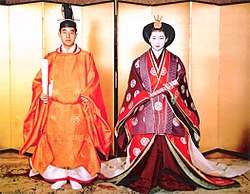


.svg.png)
